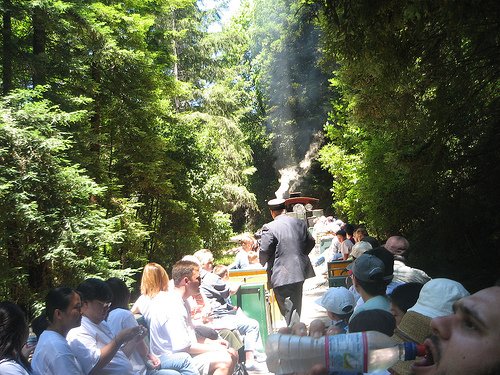Can you hear that? The buzzing sounds you hear are the murmers of excitement being uttered by everyone who’s going to be at the San Diego Comicon this weekend, July 19-23. J-List will be there in a big way, of course, and we sure hope you’ll be at the show, too — come see us in Anime Alley in the 500 aisle (I think that’s where we’ll be — anyway, just look for the Domo-kun plush toys). For information on the show, see this page.
You know you’ve been in Japan too long when you bow while speaking to someone on the telephone. It’s just one of those local mannerisms that you can’t help but pick up, like doing the swishing “come here” wave (which to Western eyes looks like “get away from me”), or “slasher hand” as you move through a crowded room. The Japanese bow in many formal and “sort of” formal situations, but like the politeness that’s built into the language itself, there are many subtle layers. If you were to meet a person you work with on the street, you might slightly lower your head and utter that all-purpose Japanese polite phrase, domo — a pretty casual greeting. Meeting with a representative from a company you do business with is obviously a more formal affair, and you would show respect by bowing lower and for a longer period of time as you exchange meishi, or business cards. Funerals are extremely solemn, and when the father of J-List’s accountant passed away, my wife gave me careful instructions about exactly how to bow when giving my condolences to him and his family.
There are many differences between Japan and the U.S. One of them is that the U.S. has inflation, while Japan does not, or not much, anyway. The accepted wisdom is that “Japan has very low inflation, but the prices are high to begin with,” and while this statement seems odd when you hear it, in practice it’s proven quite accurate. In the fifteen years I’ve lived in Japan, prices have changed very little — it used to cost $16 to take the train from our city into Tokyo, and now it’s up to $18.50, and the 350 ml Coke that used to cost $1 is now $1.20. It probably sounds nice to be paying 1995-era prices for many products, but there are downsides, too. First, gas is plenty expensive, the equivalent of $4.50 a gallon, although Japanese drivers don’t feel the pinch as much as they otherwise might since they don’t put 50 miles on the car just going to the mall like I’m doing now in California. The other downside of the lack of inflation is slow or no growth in salaries, which leads to a general economic malaise since consumer spending can’t push the country forward like it does in the States. A major part of the reason why inflation is hard to find in Japan is that land prices have fallen every year since the bursting of the economic bubble back in 1989 — they’ve down to half what they were at their height, which is bound to create more than a little economic suckage.
J-List sells our world-famous wacky Japanese T-shirts, with cool slogans in kanji and other original designs that will really make you stand out in a crowd. Our newest shirt is one that customers have requested often, a version of our best-selling “Looking for a Japanese Girlfriend” design, but on a stylish fitted girly tee, rather than our normal men’s T-shirts. It’s very kinky, looks great, and we’re sure that you or someone you know would look super in it! Why not browse all our amazing Japanese T-shirts and hoodies today?
















